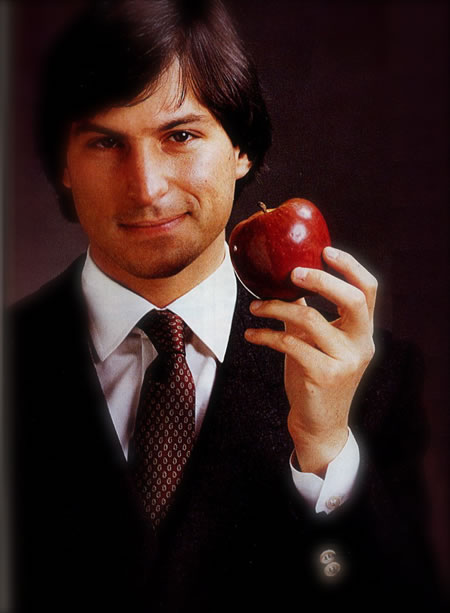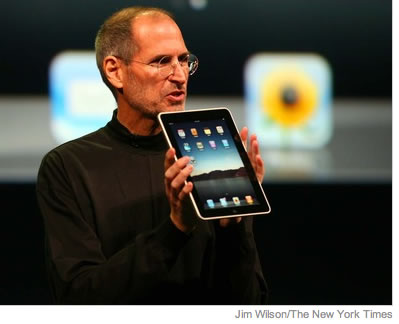
Steve Jobs, iPad and the persona of innovation.
In the past, I’ve explored the idea of the human brand, a persona driven organization type that focuses on the character of central leadership in defining brand approaches to enterprise and marketing expression.
The idea of person, alone, driving a brand isn’t new. Brands are made by people for people. Someone, inherently, will be at the top. And the long shadow that comes from that person will empower the stability of that organization. But, as the name implies, organizations are fundamentally organic — they are interrelating mechanisms that balance and flow in accordance with the spirit of the branded culture. Organizations can be active, vital and flowing expressions, or they can operate on the premise of a relatively static positioning, apparently unmoving, over time. One survives longer than another, of course — change is immanent in the character of transition and the emergence of every kind of response to trend, resonance and relevance.
Still, in virtually every organization that we work with, there is the spirit of the human brand that creates the foundation of that entity. But, when it comes to innovation, is that driven by one person, or a team of many.
From a technological heritage there are interesting turns in the development of strategies in innovation. The reasoned positioning might be that collaborative innovation is the best modeling — to the concept of that invention — it’s surely something that we practice in the concept of our innovation workshops, the Girvin BrandQuest®.
That idea of expansive brand development and innovation, for example in our work with Procter & Gamble, was about the concept of team development and group thinking in idea development on the principle that manufacturers can accelerate and improve their innovation efforts by broadening the net — engaging larger numbers of people and a more diverse set of constituencies in ideation and innovation processes. When it comes to implementation of ideas — and actualization of product conception — the findings might suggest a deviation on this turn. Managing Automation’s annual reader poll on innovation suggests that for most manufacturers, the primary source of new ideas comes from only a few individuals, not teams set up for that purpose. Confirming this trend of group innovation, however, the poll also shows that the idea of innovation teams is beginning to take hold. Already, 19% of survey respondents indicate that innovation teams in their companies are generating “future-oriented” ideas, compared with the 46% who say, as of late 2009, that only a few individuals are coming up with the key ideas. If the collaborative model has legs, these numbers should increase over time.
The concept of group, versus singular principles of ideation, continues. And in watching the scenario, Steve Lohr references his analysis of the case of innovation in relationship to Steve Jobs, and the “human brand” positioning of leadership, driving the genetic coding of the new.
“The Apple in His Eye,” writer Steve Lohr describes the ignition powering that one individual, in this case Apple CEO Steve Jobs, has in the sparkling innovation at Apple, particularly with the new iPad. We’ve commented on that as well.
The Apple-Jobs interrelationship, to his strategy, is what Lohr refers to as the “auteur model of innovation,” articulated as a “tight connection between the personality of the project leader and what is created.” He suggests that Apple products have had a history of being stylish, powerful, and pleasing to use — and being very focused. Where does that focus come from?
Working with product engineers, over the course of dozens of technology developments, there’s an art to what, in product relationships to audience and envisioning might represent. Too much, too little, on target, or off focus. Engineers are oftentimes focused on the technology and perhaps less on the notion of resonance — market relevance — but, to Apple’s positioning: “They are edited products that cut through complexity, by consciously leaving things out — not cramming every feature that came into an engineer’s head, an affliction known as ‘featuritis’ that burdens so many technology products.”
Jobs’ spectacular influence in the creation of new products at Apple and the company’s success as a result are undeniable force of business and branded nature. Lohr’s auteur model is the well spring at Apple, it works well at other environments, as well — perhaps not in the massive scale of enterprise as Apple. There are, conversely, challenges to this line of thinking. If the leader is charismatic, but as well, more eccentric in character (off the center of leading the creative rippling of the teams) the modeling won’t work. It’s one thing to have the brilliant idea, it’s another to assure the implementation. That is something that runs down the line of production, engineering and tactical actions of oftentimes enormous complexity in project product development and market articulation. Organizations that rely primarily or solely on this personality-dependent model could risk future outcomes and evolution if that leadership personality decides to leave. In a way — Apple was one thing when Steve was there, and something wholly different when he left and something renewed on his return. There are other models of this reference — in contemplating the great corporate leadership that redefined an enterprise — building it to something wholly revitalized in the market place. A.G. Lafley and his tenure at P&G completely revolutionized the organization. GE’s Jack Welch’s positioning was about the empowering the culture of leadership — building an organization that’s empowering a mastery of guidance, strategy and core outcomes. The brand leads, the leaders are the brand. To that premise then, what about irreplaceable leaders? Structure and creativity — and mentoring. John Gruber — a Drexel University computer major turned professional blogger — might be called the most forceful and articulate defender on the Web of all things Apple (AAPL).
“He came to Macworld Expo 2010, last week, however, not to praise the company but to probe its vulnerabilities. To his notations, Steve Jobs’ “most important product — the thing he’s spent the better part of his energy building since he returned to Apple — is not the Mac, the iPod, the iPhone or even the iPad. It’s Apple Inc., the company. The pessimistic dig on Apple, says Gruber, is that it’s a supremely well-organized company organized around one irreplaceable guy. The optimistic view is that Jobs has structured it to run like his other company, Pixar, which manages to turn out hit after hit, year after year, without a charismatic celebrity leader.”
Change, innovation, product creation, invention, leadership and surprise. It’s all about imagination. To the expression of making new things — a single person, something managed by teams, it’s all about the person.

TSG | Decatur Island
the reels: http://www.youtube.com/user/GIRVIN888
girvin blogs:
http://blog.girvin.com/
https://tim.girvin.com/index.php
girvin profiles and communities:
TED: http://www.ted.com/index.php/profiles/view/id/825
Behance: http://www.behance.net/GIRVIN-Branding
Flickr: http://www.flickr.com/photos/tgirvin/
Google: http://www.google.com/profiles/timgirvin
LinkedIn: http://www.linkedin.com/in/timgirvin
Facebook: http://www.facebook.com/people/Tim-Girvin/644114347
Facebook Page: http://www.facebook.com/pages/Seattle-WA/GIRVIN/91069489624
Twitter: http://twitter.com/tgirvin